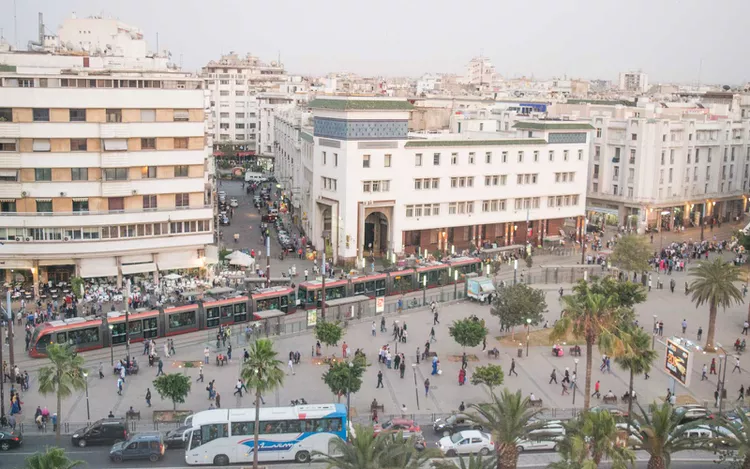Experience Casablanca: A Cultural Haven in Morocco
9 a.m. in Casablanca: It’s hot, it’s loud, it’s congested. Palm trees line the boulevards; smog and dust from construction sites cloud the air. The Atlantic Ocean gleams blue beyond.
Looking out over the urban sprawl, one could easily mistake it for Los Angeles. However, at street level, Casablanca is distinctly post-colonial. European-style sidewalk cafes and French-inspired bakeries sit in the shadow of half-built high-rises, with packs of feral street cats lounging nearby. The sound and smell of motorbikes cutting through the subtropical city center might suggest a Southeast Asian city like Hanoi, but smaller. With the sun in your eyes, there’s little to distinguish Casablanca’s half-finished neighborhoods and bustling boulevards from those of other cities in the developing world.
This Floating Restaurant Straddles the Borders of 4 African Countries — and You Can See Elephants and Hippos While You Eat
Casablanca is, by all accounts, gritty. It’s intimidating. It lacks the layer of Instagrammable gloss typically found in Marrakesh, Essaouira, and Fez. Consequently, there’s a preconceived notion among many tourists that the only thing to do in Casablanca is to leave. Many guides to Morocco skip over Casablanca completely, treating it only as a transit hub.
However, Casablanca’s refusal to cater to Western tourists’ tastes is exactly what makes it intriguing. Here, in the nation’s largest city, the current and next generations of Moroccans can have career paths outside the service industry and lives that do not revolve around serving wealthy visitors. Contemporary art spaces celebrate young, local talent. DJs channel the sounds of AfrikaBurn (Africa’s regional Burning Man event). Furthermore, the markets are meant for locals buying groceries, rather than tourists purchasing prized Berber rugs. This is Morocco in real life, providing cultural context essential for understanding and appreciating the rest of the country.
How to Get There and Get Around Casablanca
Although Africa might seem far away, a direct flight from New York to Casablanca is only 6 hours and 45 minutes, about the same duration as flying to London. Royal Air Maroc offers affordable direct flights between the two cities.
Once on the ground, the best way to navigate Casablanca is through its taxis. “Grande taxis” go to and from the airport, while “petit taxis” serve commutes within the city. Be aware that taxi drivers in Casablanca may try to hustle Western tourists for high fares. Unfortunately, you can’t always avoid this, especially if you’re in a part of town lacking taxi traffic. The best strategy is to request that the driver use the meter (“le comptoir” in French) as soon as you get in. A taxi from one end of Casablanca to the other shouldn’t exceed $5. Moreover, petit taxis operate like Uber Pools during rush hour, so don’t be surprised if yours stops to pick up additional passengers.
Where to Eat
Breakfast: Start your day al-fresco in the garden of La Sqala. Their complete Moroccan breakfast includes eggs, sweet pastries, dates, and bread with ricotta, olives, and various condiments.
Lunch: The best lunch in Casablanca can be found among the fresh seafood stalls at the city’s Central Marketplace. Here, you can buy seafood from any vendor in the indoor market and have the outdoor shops prepare it for you. Huge lobsters can provide a luxurious meal for 2 to 4 people. Be sure to try the sea urchin vendor, who will crack open fresh ones for you to enjoy right from the shell, priced five for about one US dollar.
Dinner, Drinks, and Music: Le Cabestan stands out as the city’s most notable nightclub and dining establishment. Located right on the water, this contemporary venue evokes a vibe similar to Malibu or Cannes, but with a more international crowd. Wealthy locals enjoy bottle service while young local DJs spin house records throughout the night.
What to See and Do
Hassan II Mosque
Morocco is renowned for its crafts, and this stunning mosque showcases that craftsmanship on a grand scale. Hassan II is one of the largest mosques in Africa, and it is one of the few mosques in Morocco open to non-Muslims. (It’s important to dress appropriately for entry.) Built on a platform extending into the water, the stone structure and its 210-foot minaret make it the city’s most iconic landmark.
The Medina
While Berber markets in Fez and Marrakesh focus on rugs, silks, and spices, Casablanca’s ancient Berber market is filled with live chickens, fish, vegetables, bootleg soccer jerseys, and local clothing. Here, haggling with shopkeepers over the price of babouches provides a friendlier, lower-pressure experience compared to other cities where vendors depend heavily on tourist dollars.





